Tamiya 1/48th
Crusader Mk.I/II
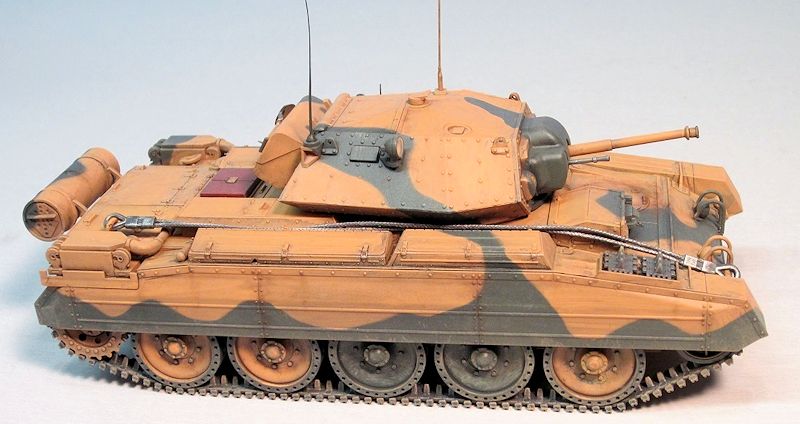
For the most
part, British tanks of the WWII era were ugly, unreliable, under gunned, under
armored, cramped, hard to get out of, etc. There were few bright spots, one
being the Matilda – at least until the Germans turned their 88s on them. The
Crusader tanks were a good looking line of “Cruiser” type machines. They were
low slung and surprisingly modern in appearance, much more so than their
replacement - the Cromwell. They were fast and agile but still very British in
their thin armor, 2-pdr. main gun, deplorable reliability, and cramped crew
quarters. I recently watched a documentary on British tankers of the period.
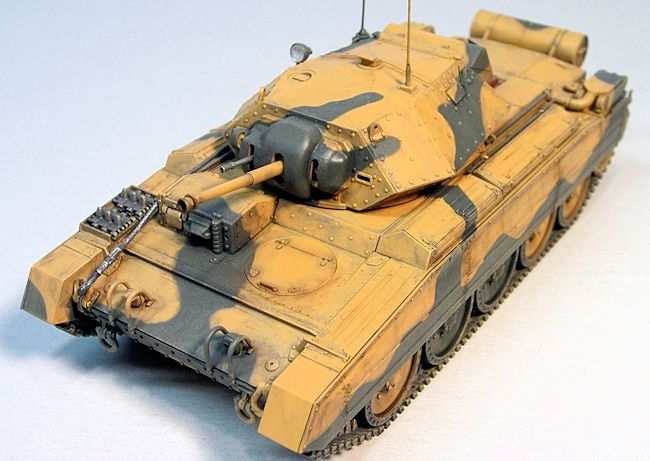 Without exception, all the surviving men spoke bitterly about being sent into
battle in the inferior British tanks.
Without exception, all the surviving men spoke bitterly about being sent into
battle in the inferior British tanks.
From
the kit instructions: “From the late 1930s, British army doctrine called for the
development of two main types of tanks, the heavily armored infantry tank and
the faster ‘Cruiser’ tank. With WWII looming, Nuffield was offered a role in
developing the A13 Mk.III Covenanter tank, but the company declined and chose to
proceed with the development of its own model, the A15 Crusader. Problems with
the Covenanter eventually saw the Crusader replacing it in mass production.
Initial armament was a 2-pounder gun in the main turret and a Besa machine gun
in an auxiliary hull turret. The 18.8 ton tank had high mobility and a top speed
of over 40km/h thanks to its Christie suspension and 12-cylinder Liberty engine,
but armor protection was sacrificed as the Crusader only had relatively thin
20mm turret and 26mm hull frontal armor. Production of the Crusader Mk.I began
in May 1941 and they were first sent to North Africa to equip the 7th
Armored Division. The tank’s baptism of fire came during an attempt to relieve
besieged Tobruk, Operation Battleaxe, where it was outmatched by the better
armed Panzer III and had issues with reliability. Taking lessons from combat
experience, the MkII featured improved armor protection and had the ineffective
machine gun turret removed, while the final Mk.III variant featured a more
powerful 6-pounder gun. Production ended in 1943 with a total of 5,300 Crusaders
produced, and despite its shortcomings, the tank played an important role in the
Allied victory in North Africa.”
Tamiya’s
1/48th Crusader Mk.I/II is number 41 in their Military Miniatures
series. The instructions are well printed and easy to follow. The engineering of
the Tamiya Crusader is superb, resulting in beautiful detail without difficult
construction or an excessive parts count. The kit is crisply molded in tan
plastic and there is almost no flash on the kit parts. No figure is included.
The kit decals are thin, in register, and provide markings for five North
African tanks. There is a metal chassis and nice link and length tracks with the
longer portions pre-formed, minimizing assembly time.
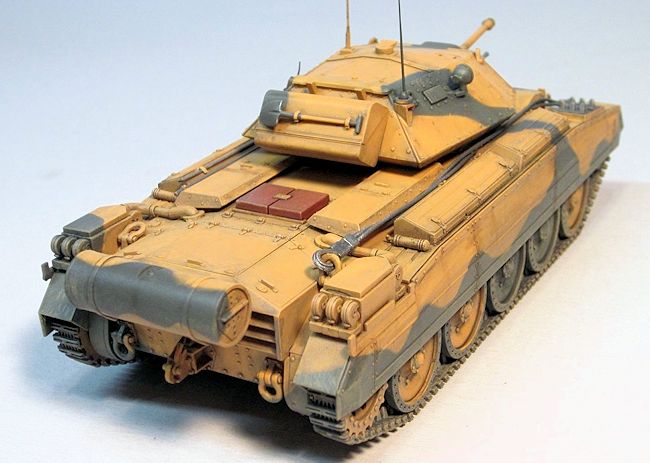 Differing
somewhat from the kit instructions’ assembly sequence, I built the kit in three
major sub-assemblies: the chassis, the upper hull, and the turret. I left the
tracks off until after painting for ease of weathering. The metal chassis
required the use of Super Glue when I installed the road wheels and other
plastic parts attached to it. The excellent fit of the parts, minimal cleanup
and excellent engineering really made for a rewarding and painless build. After
about five hours of building, I had the three main components (chassis, upper
hull and turret) ready for paint. The only speed bump during construction was
that the tracks were a link short on each side. Thankfully, there were extra
links included and the tracks fit great once these were added. I think the
problem was simply an omission in the instructions.
Differing
somewhat from the kit instructions’ assembly sequence, I built the kit in three
major sub-assemblies: the chassis, the upper hull, and the turret. I left the
tracks off until after painting for ease of weathering. The metal chassis
required the use of Super Glue when I installed the road wheels and other
plastic parts attached to it. The excellent fit of the parts, minimal cleanup
and excellent engineering really made for a rewarding and painless build. After
about five hours of building, I had the three main components (chassis, upper
hull and turret) ready for paint. The only speed bump during construction was
that the tracks were a link short on each side. Thankfully, there were extra
links included and the tracks fit great once these were added. I think the
problem was simply an omission in the instructions.
I
chose the fifth of the kit markings - option “E”, a Crusader Mk.II of the 1st
Armored Division, El Hamma, March 1943. First, everything was airbrushed
PolyScale acrylic Deck Tan thinned with Future. Thinning with Future helped the
paints spray better and the satin finish was better suited to washes/filters.
Next came the unpleasant (for me) three hour task of masking for the darker camo
color. I used a kneadable eraser rolled
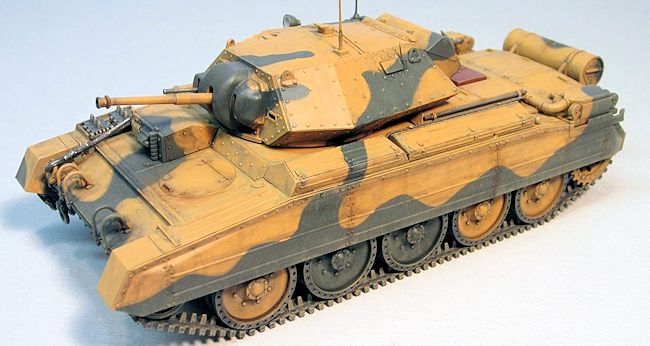 into thin “snakes” to outline the camo
and then I used pieces of the same eraser pressed flat to mask off the rest of
the tan. I sprayed PolyScale acrylic RLM 73 for the darker camo color.
into thin “snakes” to outline the camo
and then I used pieces of the same eraser pressed flat to mask off the rest of
the tan. I sprayed PolyScale acrylic RLM 73 for the darker camo color.
The
tracks were brush-painted dark gray next. They were dry-brushed with Testors
oil-based silver prior to installation and weathering.
I
started the weathering process by applying a thin, black, soapy water
filter/wash. I went section by section, using a Q-tip to remove some of the wash
and to streak it unevenly. I then dry-brushed some thinned Deck Tan and RLM 73
to accent detail and further vary tone. Once the tracks were installed, the
tracks and chassis were strategically dry-brushed with Italian Hazel Tan paint
to approximate the dusty North African conditions in which these tanks operated.
Good pictures of actual Crusader Mk.IIs proved invaluable during the weathering
process.
The
upper hull was screwed to the chassis and the turret was added. I then
air-brushed Poly Scale Flat Clear mixed with a few drops of Hazel Tan over the
entire tank. I used pastels to further dirty the Crusader. I added two stretched
sprue antennae and final detailing was then completed.
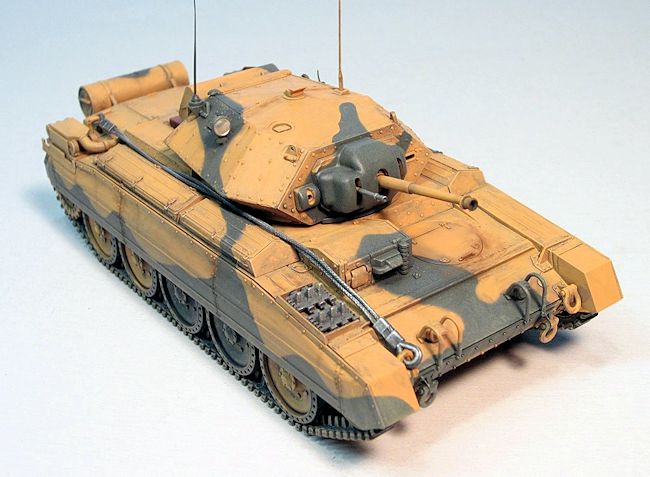 Tamiya has
created another winner with this kit. From start to finish it took me less than
15 hours over the course of a week! Construction of the Crusader Mk.II was
enjoyable and relaxing with no real problem spots to speak of. Tamiya’s smart
engineering, terrific fit, and beautiful moldings resulted in a great looking
finished product. The two tone paint scheme was a challenge but I liked the end
result. I really enjoyed Tamiya’s small scale Crusader. Highly recommended!
Tamiya has
created another winner with this kit. From start to finish it took me less than
15 hours over the course of a week! Construction of the Crusader Mk.II was
enjoyable and relaxing with no real problem spots to speak of. Tamiya’s smart
engineering, terrific fit, and beautiful moldings resulted in a great looking
finished product. The two tone paint scheme was a challenge but I liked the end
result. I really enjoyed Tamiya’s small scale Crusader. Highly recommended!
Jonathan
Prestidge
April 2014
If you would like your product reviewed fairly and fairly quickly, please contact the editor or see other details in the
Note to
Contributors.
Back to the Main Page
Back to the Review
Index Page


 Without exception, all the surviving men spoke bitterly about being sent into
battle in the inferior British tanks.
Without exception, all the surviving men spoke bitterly about being sent into
battle in the inferior British tanks.  Differing
somewhat from the kit instructions’ assembly sequence, I built the kit in three
major sub-assemblies: the chassis, the upper hull, and the turret. I left the
tracks off until after painting for ease of weathering. The metal chassis
required the use of Super Glue when I installed the road wheels and other
plastic parts attached to it. The excellent fit of the parts, minimal cleanup
and excellent engineering really made for a rewarding and painless build. After
about five hours of building, I had the three main components (chassis, upper
hull and turret) ready for paint. The only speed bump during construction was
that the tracks were a link short on each side. Thankfully, there were extra
links included and the tracks fit great once these were added. I think the
problem was simply an omission in the instructions.
Differing
somewhat from the kit instructions’ assembly sequence, I built the kit in three
major sub-assemblies: the chassis, the upper hull, and the turret. I left the
tracks off until after painting for ease of weathering. The metal chassis
required the use of Super Glue when I installed the road wheels and other
plastic parts attached to it. The excellent fit of the parts, minimal cleanup
and excellent engineering really made for a rewarding and painless build. After
about five hours of building, I had the three main components (chassis, upper
hull and turret) ready for paint. The only speed bump during construction was
that the tracks were a link short on each side. Thankfully, there were extra
links included and the tracks fit great once these were added. I think the
problem was simply an omission in the instructions.  into thin “snakes” to outline the camo
and then I used pieces of the same eraser pressed flat to mask off the rest of
the tan. I sprayed PolyScale acrylic RLM 73 for the darker camo color.
into thin “snakes” to outline the camo
and then I used pieces of the same eraser pressed flat to mask off the rest of
the tan. I sprayed PolyScale acrylic RLM 73 for the darker camo color.  Tamiya has
created another winner with this kit. From start to finish it took me less than
15 hours over the course of a week! Construction of the Crusader Mk.II was
enjoyable and relaxing with no real problem spots to speak of. Tamiya’s smart
engineering, terrific fit, and beautiful moldings resulted in a great looking
finished product. The two tone paint scheme was a challenge but I liked the end
result. I really enjoyed Tamiya’s small scale Crusader. Highly recommended!
Tamiya has
created another winner with this kit. From start to finish it took me less than
15 hours over the course of a week! Construction of the Crusader Mk.II was
enjoyable and relaxing with no real problem spots to speak of. Tamiya’s smart
engineering, terrific fit, and beautiful moldings resulted in a great looking
finished product. The two tone paint scheme was a challenge but I liked the end
result. I really enjoyed Tamiya’s small scale Crusader. Highly recommended!